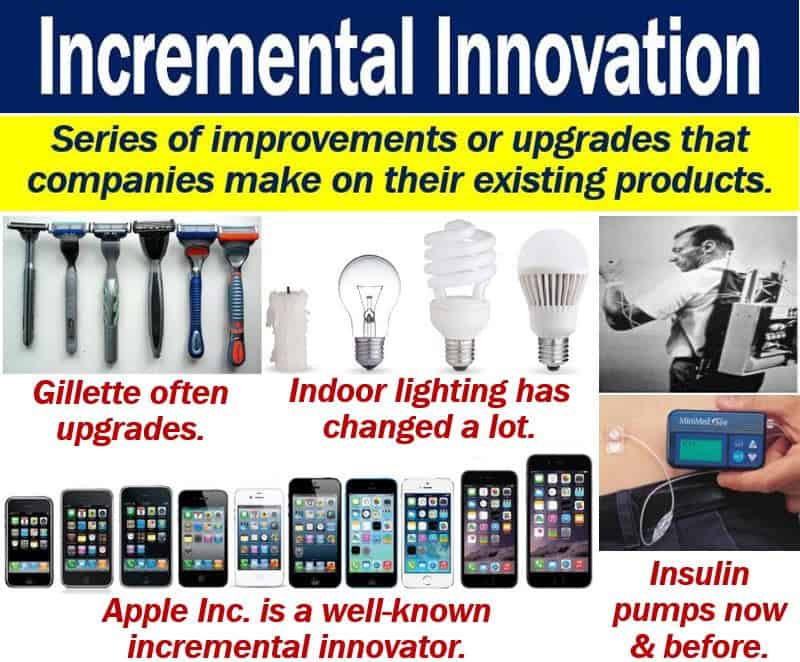Incremental Innovation is a succession of very Small Upgrades or Improvements that a company makes to its products. The company makes small improvements at regular intervals.
The term may also apply to services, methods, or processes. Innovative companies carry out many small improvements over time to maintain brand loyalty. They may also do it to hold onto market share. In other words, they want consumers either to buy their new upgrades or keep their existing products.
Upgrades and customer behavior
Customers are more likely to hold onto an existing product if there is an interesting software upgrade, for example.
Incremental innovation is a strategy that helps companies maintain or improve their competitive position over time.
Incremental innovation is common among high-technology companies. In the hi-tech consumer market, people are always keen on new product features.
Furthermore, consumer technology makers are always introducing new features to existing products.
Therefore, any company that fails to introduce small improvements at regular intervals will lose out significantly.
According to an article from Northeastern University, Boston, Massachusetts, USA:
“The term “incremental innovation” refers to a series of small improvements made to a company’s existing products or services. Generally, these low-cost improvements help further differentiate a company from the competition while building on current offerings.”
This incremental innovation approach allows companies to continuously adapt to consumer feedback, ensuring products evolve in line with customer needs and market trends.
Innovation means thinking up and creating new ways of doing and making things. It also includes creating new products. It is a crucial part of many successful businesses.

Incremental innovation vs. other types
This type of innovation is often a better investment than other innovation types. In today’s rapidly changing marketplace, many managers underrate the benefits of a series of small improvements or upgrades.
In this context, the term ‘marketplace’ means the same as the abstract meaning of ‘market.’
According to Decision Innovation, overall innovation failure rates are extremely high, i.e., 70% to 98%.
Incremental changes to existing products have a much lower failure rate.
Regarding incremental and other innovation types, Decision Innovation writes:
“Contending with this level of failure makes incremental changes look attractive when considering the risk associated with innovation investments.”
Incremental innovation – existing products
Incremental innovation focuses on existing products. The aim is to improve an existing product’s efficiency, features, productivity, or competitive differentiation.
Competitive differentiation is a positioning tactic a company undertakes to set its product apart from competing products.
Companies use this type of innovation to help maintain market share and position. They may also use it to improve the product’s market position.
It has become a common tactic among consumer technology producers. Smartphone makers and other consumer technology manufacturers/creators compete fiercely to improve devices with new features.
An example of incremental innovation
An example of incremental innovation can be seen in the updates made to the Microsoft Office Suite over the years. Periodically, Microsoft has made small improvements to its suite of products, including Word, Excel, PowerPoint, and Outlook, among others.
Each new version or upgrade has come with subtle changes to the user interface, added features, and improved performance. The introduction of the “Ribbon” toolbar in Office 2007, for example, was an incremental upgrade that made navigation more intuitive.
Later versions added collaborative editing, cloud services, and AI-based functions like data analysis predictions in Excel, and automated design suggestions in PowerPoint.
The world of innovations – vocabulary
There are many compound phrases that describe different types of innovation. Let’s have a look at some of them, understand their meanings, and see how each one is used in a sentence:
-
Radical Innovation
Transformative advancements that significantly alter existing systems or create new categories.
Example: “The introduction of the smartphone was a radical innovation that changed the way we communicate.”
-
Disruptive Innovation
Innovations that disrupt and eventually displace established market leaders.
Example: “Streaming services represent disruptive innovation, challenging traditional television and movie distribution.”
-
Open Innovation
A strategy where businesses use external ideas and innovations to advance their operations.
Example: “The company’s open innovation program invited ideas from the public, leading to breakthrough products.”
-
Sustainable Innovation
Innovations that prioritize environmental health and resource conservation.
Example: “Electric cars are a form of sustainable innovation that reduces reliance on fossil fuels.”
-
Breakthrough Innovation
Significant discoveries or developments that create a new market.
Example: “The development of the CRISPR gene-editing technology was a breakthrough innovation in biotechnology.”
-
Service Innovation
Creating or improving services to add value for users.
Example: “The bank’s introduction of online banking was a service innovation that enhanced customer convenience.”
Educational Video – What is Incremental Innovation?
This interesting video presentation, from our sister channel in YouTube – Marketing Business Network, explains what ‘Incremental Innovation’ is using simple and easy-to-understand language and examples.
